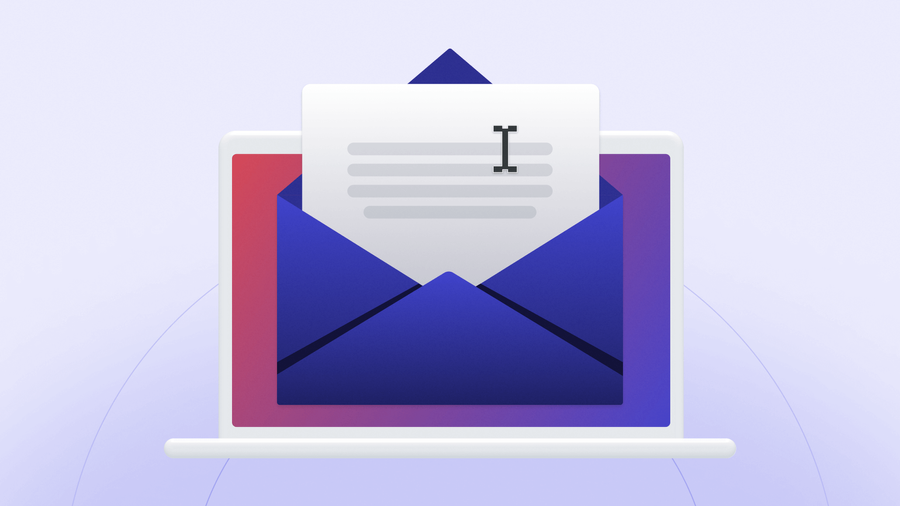How many marketing emails do you think you ignore, avoid, or otherwise gloss over in a given day? More often than not, this (incredibly common) neglect is due to three things: a lack of relevancy, poorly written email content, or a disastrous combination of the two.
Regarding relevancy, we’ve covered some excellent tips in our guide to email segmentation best practices. Now, however, we’re taking a closer look at how to write marketing emails that convert — from your email header to body content to responsive email design choices you should consider with every single send.
Believe it or not, some of your most foundational decisions, like word choice and email marketing structure, can make a massive difference in click-through rates, mobile app retention, and overall brand perception. In other words, a marketing email that is easy on the eyes is easy ROI.
A Note on Responsive Email Design
Responsive design refers to creating email templates that adapt and adjust their layout and email content based on the device used by the recipient to ensure an optimal viewing experience across all screen sizes.
More people than ever rely on their mobile devices for accessing emails, and responsive design has become increasingly important for marketers to effectively engage their audience accordingly. By ensuring that marketing emails are easily accessible and readable on mobile devices, mobile-first businesses can enhance their users’ experience, increase engagement, and drive conversions.
Implementing responsive design involves several best practices for marketing emails to ensure effectiveness:
- Use a single-column layout: Simplify the email layout by using a single-column design, which is easier to navigate on smaller screens.
- Optimize font sizes: Use larger font sizes to ensure readability on mobile devices without the need for zooming.
- Include clear and prominent calls-to-action (CTAs): Make CTAs easily clickable and visible without scrolling, encouraging recipients to take action.
- Minimize image file sizes: Optimize images for faster loading times on mobile devices, reducing the risk of recipients abandoning the email due to slow load times.
- Test across multiple devices and email clients: Ensure that the responsive design functions as intended on various devices and email clients to provide a consistent experience for all recipients.
- Provide a fallback for non-responsive email clients: Include a fallback design for email clients that do not support responsive design to ensure readability and usability for all recipients.
Ready to dive deeper into the world of mobile-first email? We have a guide specifically dedicated to responsive email design!
How to Structure Marketing Emails
A well-structured email instantly captures attention, conveys professionalism, and establishes credibility. The strategic placement of elements such as the header, body, and footer sets the tone for the entire message, guiding recipients through a seamless user journey and helping your message resonate with recipients on a subconscious level.
So, what should be included in a marketing email?
Email Envelope
The email envelope consists of the email header and metadata, which include information such as the sender's email address, recipient's email address, subject line, date and time of transmission, and other routing information.
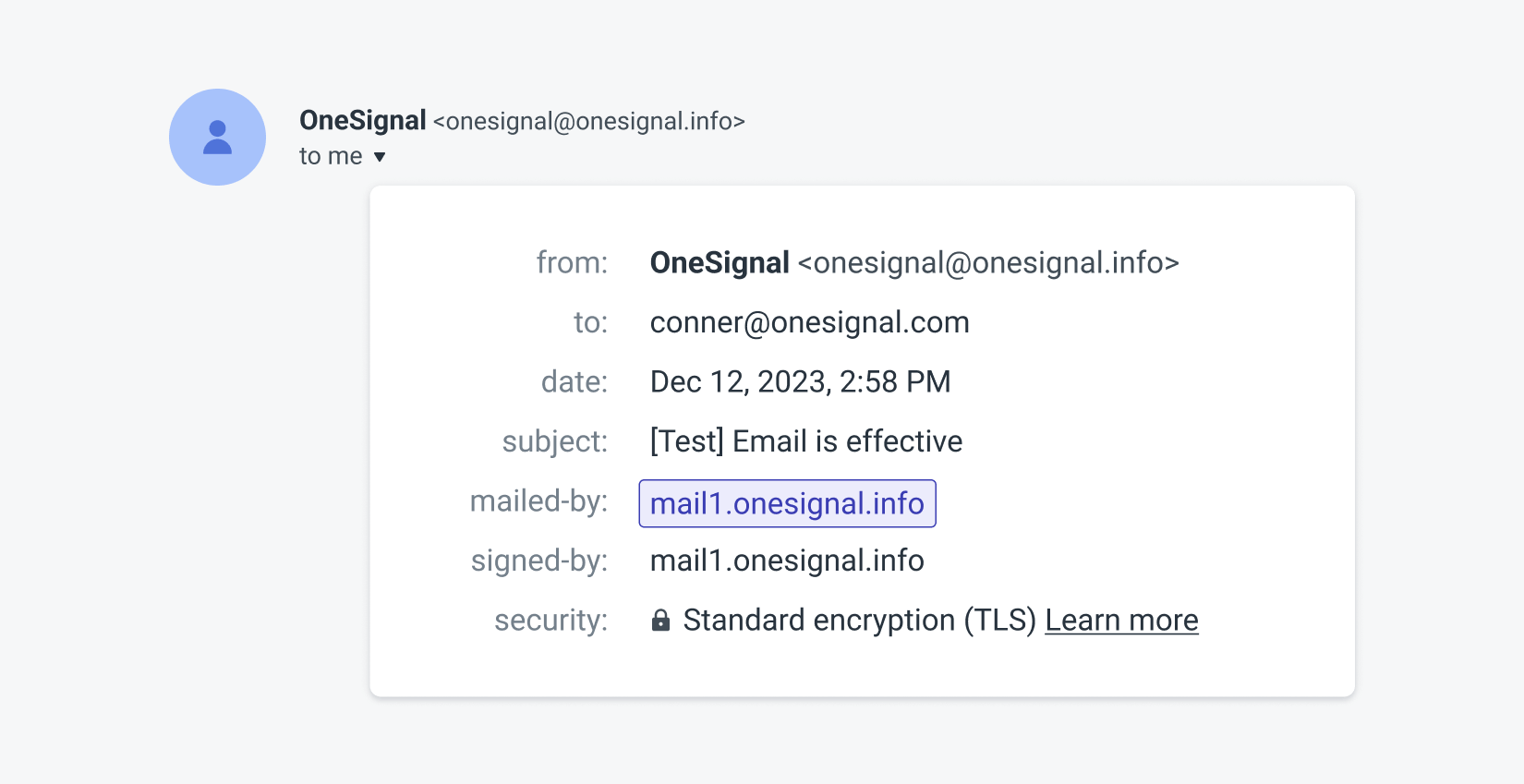
The email envelope is not typically visible to recipients when they open an email but is crucial for properly routing and delivering the message. While the email envelope doesn't directly impact the visual or content structure of the email, it is a fundamental component of communication that helps ensure the email deliverability and integrity of marketing campaigns.
Is there a difference between the email envelope and the email header?
The email envelope and the header are both components of an email message, but they serve different purposes. The email envelope contains technical information necessary for the delivery of the email, such as the sender and recipient addresses, subject line, and routing details. In contrast, the email header is part of the email's content visible to the recipient and typically includes elements like the sender's name, subject line, and any additional information or branding.
Best Practices for Marketing Email Envelopes Include:
Authentication
Ensure that your email server is properly authenticated using mechanisms like SPF, DKIM, and DMARC to prevent your emails from being flagged as spam. Don’t know where to start? Our guide to how to set up DMARC goes into more detail!
Reputation Management
Maintain a positive sender reputation by regularly monitoring bounce rates, email spam complaints, and engagement metrics. Avoid sending emails from domains with a poor reputation. Explore how and why emails bounce to better preserve your sender reputation.
List Hygiene
Keep your email lists clean by regularly removing inactive or invalid email addresses. High bounce rates can negatively impact your sender reputation and deliverability. This step-by-step guide will help you learn how to clean an email list to boost deliverability.
Clear Sender Information
Use a recognizable sender name and email address to build trust with recipients and increase the likelihood of your emails being opened. Go above and beyond with these key factors that affect email deliverability and start locking in trust with your recipients sooner rather than later.
Subject Line Relevance
Craft compelling subject lines that accurately reflect your email body content to improve open rates and reduce the risk of being marked as spam. Check out these 10 tips for writing better email subject lines to increase your open rates with personalized and relevant content.
Avoid Spam Triggers
Steer clear of spammy language, excessive use of symbols or capitalization, and misleading content in both your email envelope and header. To dive deeper into the wonderful world of spam, this guide to avoiding email spam traps tells you exactly how to stay out of hot water with email compliance regulations.
Personalization
An effective email subject line can maximize open rates by capturing the recipient's attention, piquing their curiosity, and conveying the value or benefit of opening the email. Using personalized elements such as the recipient's name or relevant details can make the subject line feel more tailored and engaging. Consider adding personal touches like user location, past purchase or browsing history, birthdays or anniversaries, or in-app milestones to increase the likelihood of recipients opening and engaging with your emails
Explore these email segmentation best practices to make your marketing emails feel one-of-kind for each and every recipient.
Email Header
Your email header is the topmost portion of your visible email and where your recipients will make most of their snap judgments about your brand. This is the gateway to your email content, making it crucial for capturing user attention. A well-designed and engaging header immediately grabs the reader's attention, enticing them to continue reading the rest of the email content. With limited time and attention spans, a compelling email body header can make all the difference in whether recipients engage with your message or move on.
Typically, email headers present your company logo, placed prominently across the top of the email to reinforce brand identity.
Best Practices for Marketing Email Headers:
Clear Hierarchy

In crafting the header for your marketing email, clarity is paramount. A clear hierarchy ensures that your message is easily digestible for your audience. Begin with your company logo, serving as the anchor for your content. Many email headers, such as the above example from REI, also incorporate a simplified menu next to their logos, directing readers to relevant website links or deep linked app destinations.
Menus should be concise — don’t overwhelm people with too many options. This structured approach guides the reader's eye seamlessly across the header, enabling them to intake multiple points of interest at a glance.
Whitespace
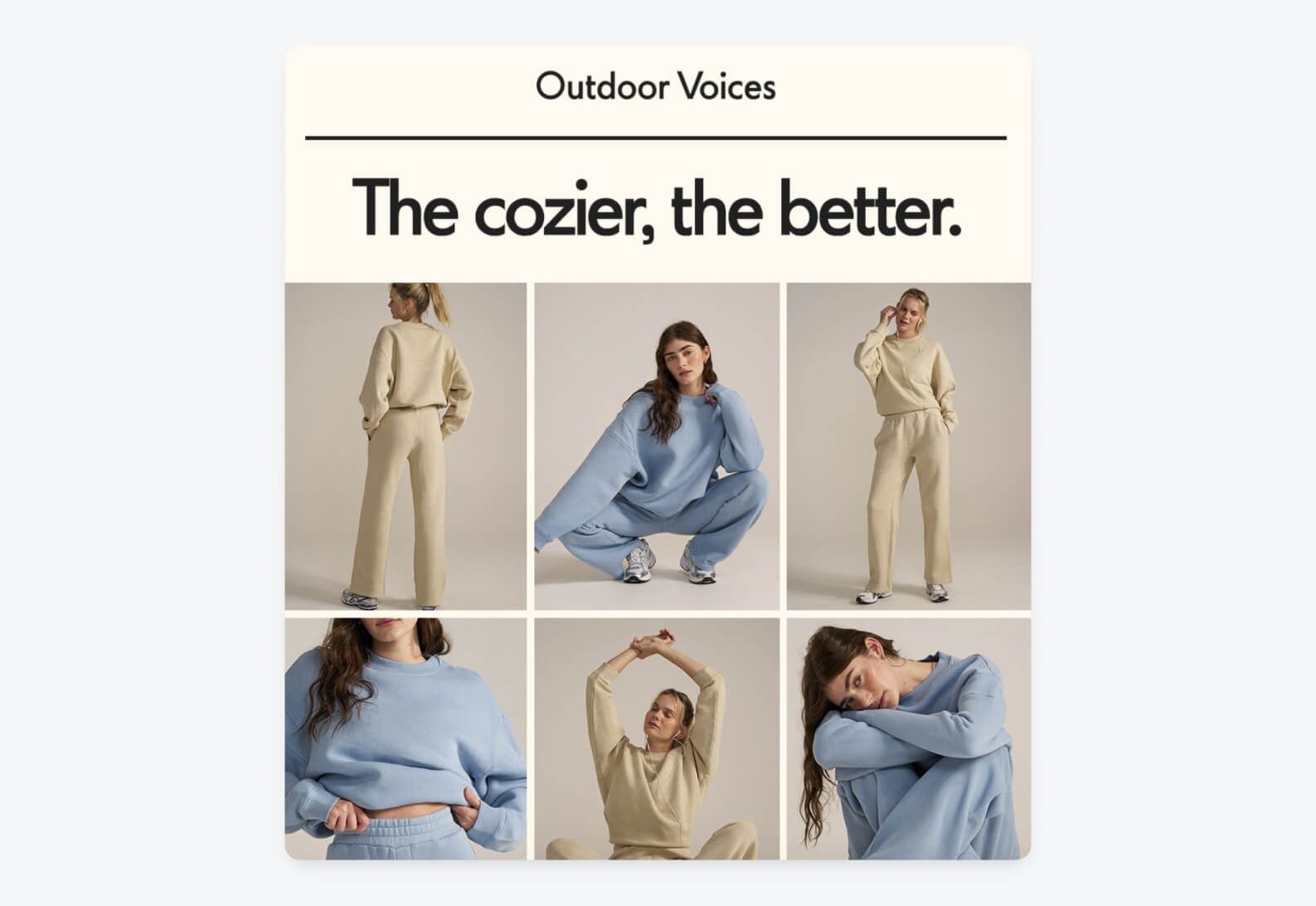
Whitespace, often overlooked yet crucial, plays a significant role in the effectiveness of your email header. It provides breathing room around design elements, preventing visual clutter and enhancing readability. Strategically employed whitespace (or in the case of the above example from Outdoor Voices, off-white-space) creates a sense of balance and allows their headline and imagery to stand out. By giving each component in the header room to breathe, you create a more inviting and visually appealing experience for your readers. Sometimes all you need is your logo with a minimal and aesthetically appealing design.
Personalization
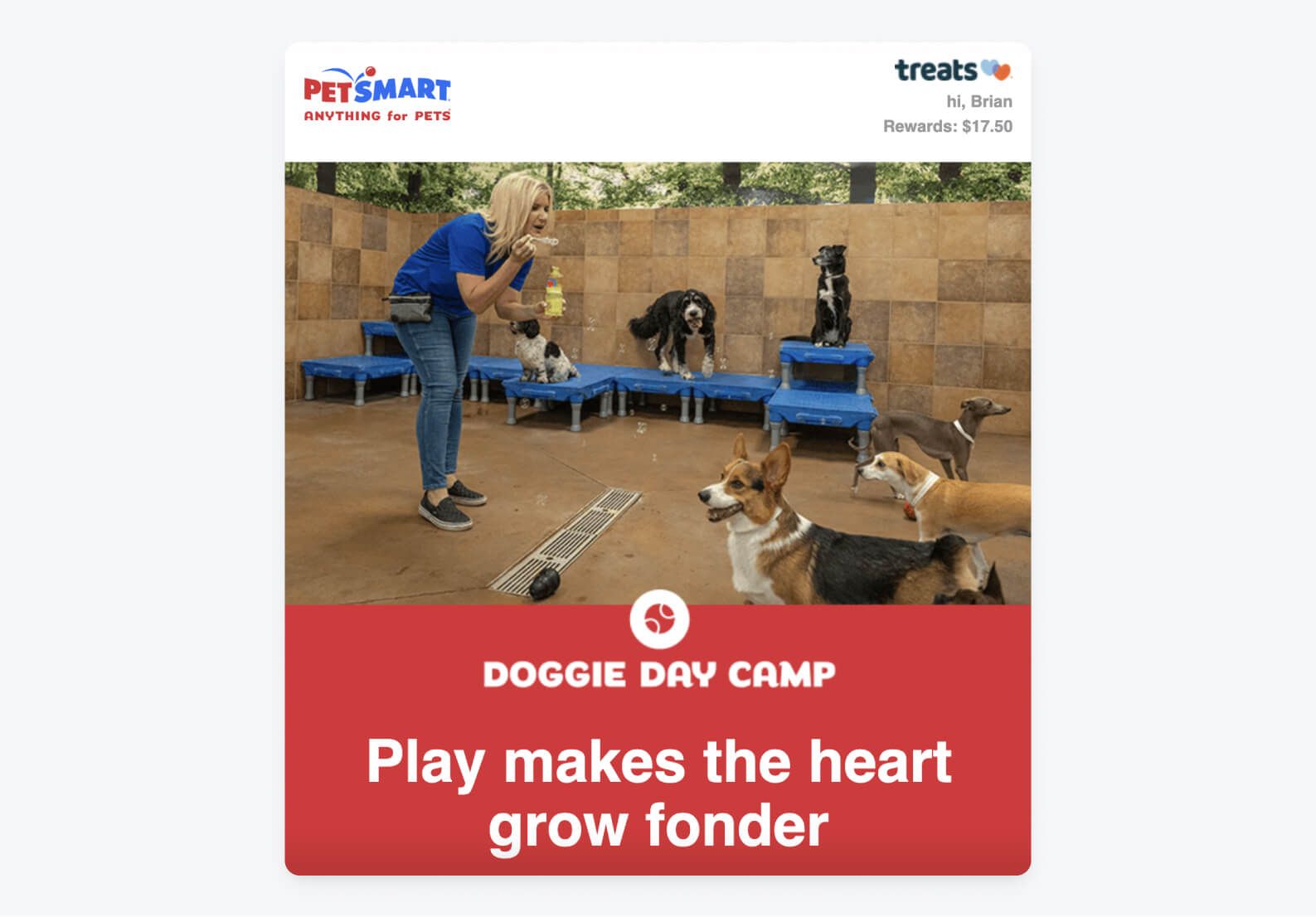
Personalization is the key to forging meaningful connections with your audience. Incorporating personalized elements into your email header, such as addressing the recipient by name, makes the communication feel tailored to their individual needs and preferences. The above example from PetSmart not only includes the recipient’s name but also their current rewards balance. For businesses or apps that rely on user rewards or virtual currency, this is an excellent touch to make your emails feel more intimate and remind recipients that an engagement opportunity is waiting for them.
These small human touches to your email header make it as compelling as it is impactful.
Bonus Email Header Tips:
- Less is often more — Keeping text concise and focused ensures your message is clear and impactful. Grab attention at the top, while conjuring a slight degree of intrigue to keep people scrolling!
- Be economical in design — Don’t waste vertical space with clunky or unnecessary email design elements. Keep your email header slim and rectangular (remember, your header is just the opening act for the body of your email!)
- Dynamic content sets yourself apart — Add an animated gif to bring your email header to life, grab attention, and showcase your brand identity.
- Don’t forget the dark side — Design an alternate version of your email header to blend seamlessly with your email users who use dark mode (it’s becoming increasingly popular!) Check out our guide to optimizing emails for dark mode to learn about this trending user preference.
Email Body
The email body refers to the main content area of your email message where you’ll convey your primary message, offers, and more detailed information to recipients. It typically includes text, images, links, and calls to action aimed at engaging users and driving desired actions.
A well-crafted email body is stimulating to read (rather than reading like an advertisement), captures attention, maintains interest, and ultimately persuades recipients to take action, whether it's making a purchase, signing up for a webinar, or visiting a website
What Are the Components of a Strong-Performing Email Body?
1. Compelling Introduction

Your introduction sets the tone for the email and grabs the reader's attention from the outset. Start with a captivating opening sentence or headline that intrigues the recipient and entices them to continue reading. Use the introduction to establish relevance and pique curiosity about the email content that follows.
Tip: Personalize the introduction whenever possible to make the email feel more tailored to the recipient's interests or past interactions. Incorporate the recipient's name or reference previous purchases and interactions to create a connection and increase engagement.
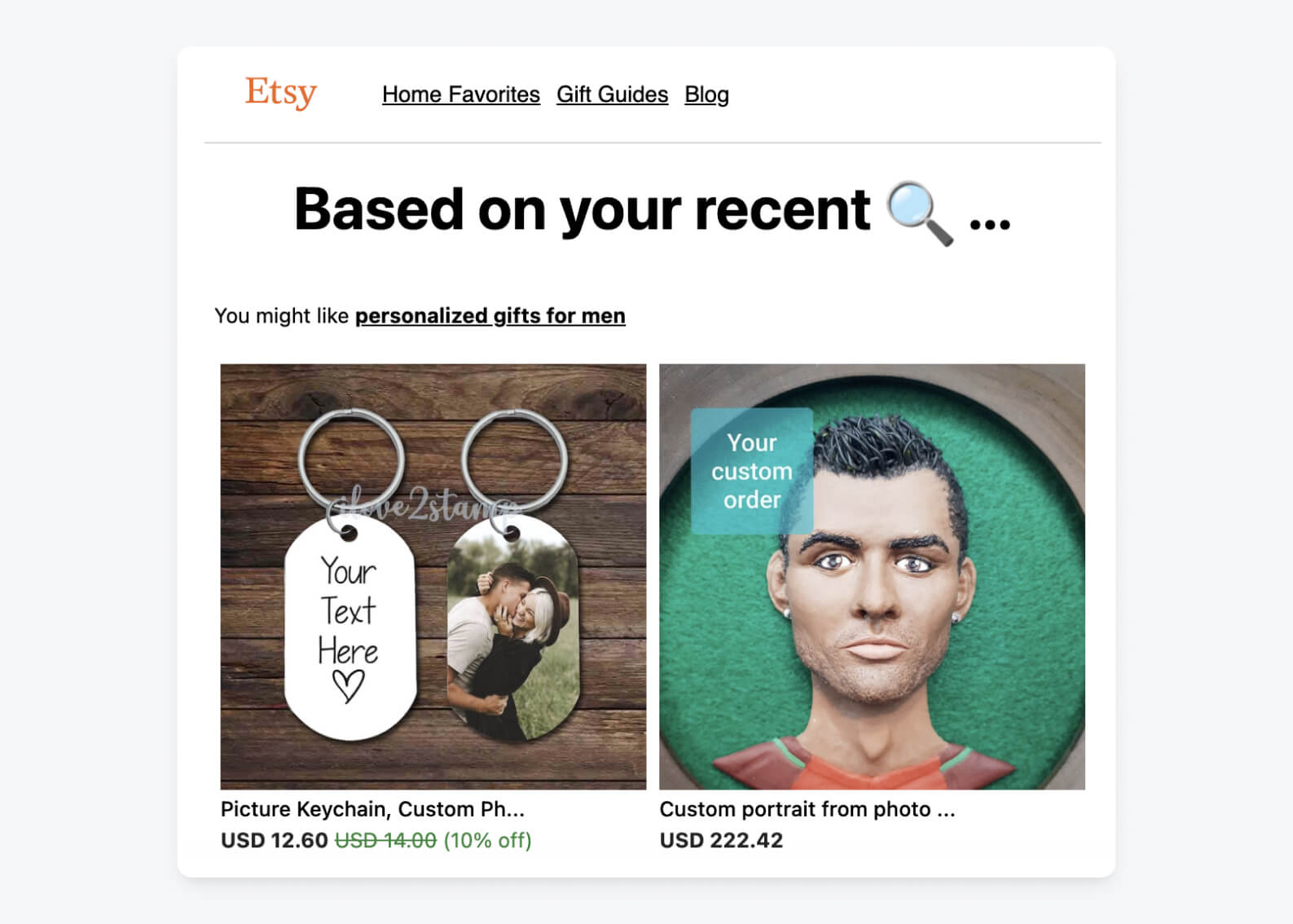
2. Persuasive Email Content
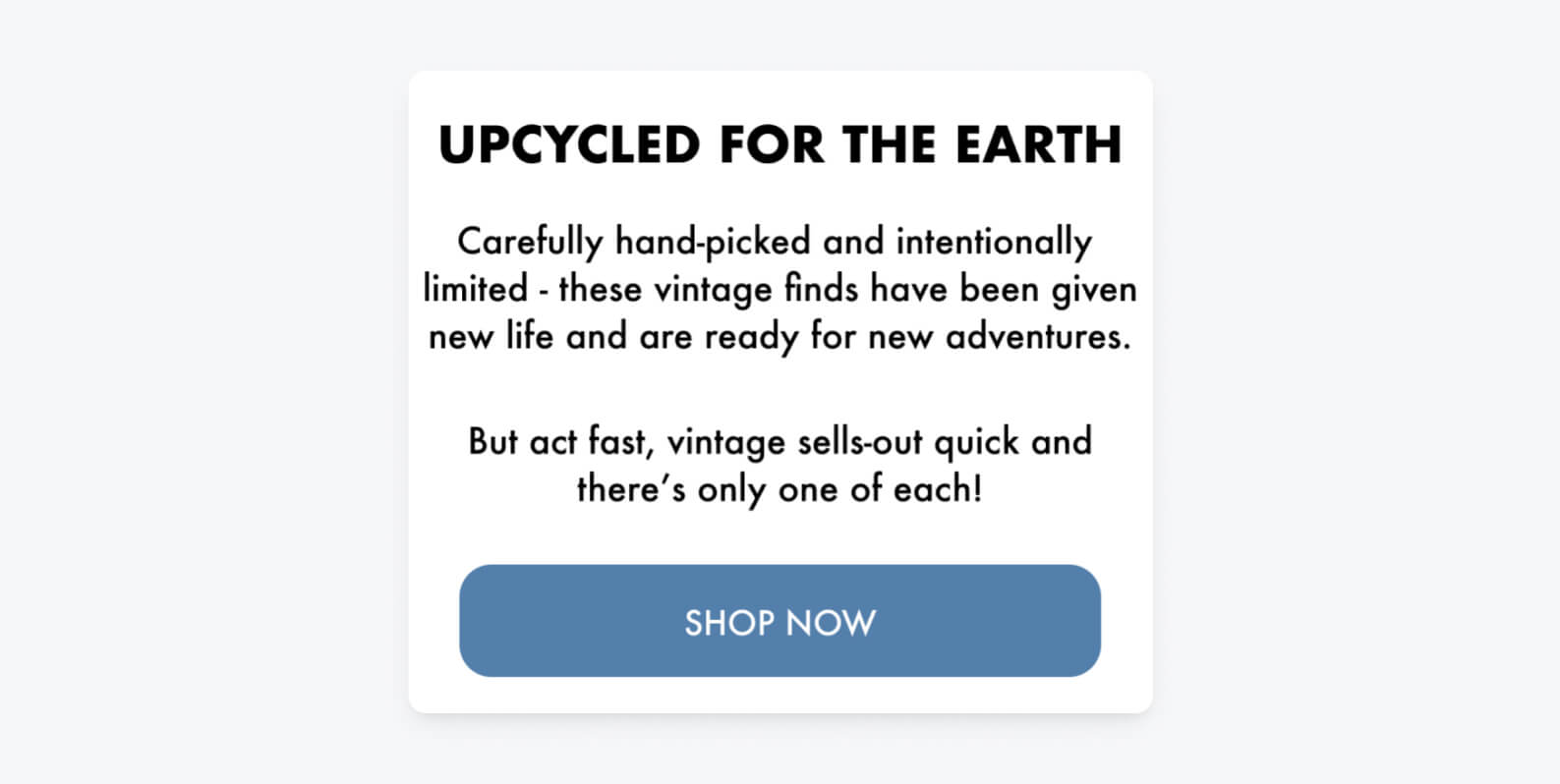
The body of the email is where you deliver your message, offer, or value proposition to the recipient. Keep the content clear, concise, and focused on the key points you want to communicate. Use persuasive language and compelling visuals to convey your message effectively and evoke an emotional response from the recipient. The above example from Parks Project does a wonderful job leveraging authenticity and FOMO to drive their short, but persuasive email copy about their limited product line!
Tip: Use storytelling techniques to engage the reader and make your message more memorable. Share customer success stories, case studies, or testimonials to demonstrate the benefits of your product or service in action.
The below example from Fresh Patch has an entire section of their email body dedicated to customer testimonials and even an opportunity to get involved with their social media campaign. This is a powerful way to make your email recipients feel less like customers and more like a part of the community.
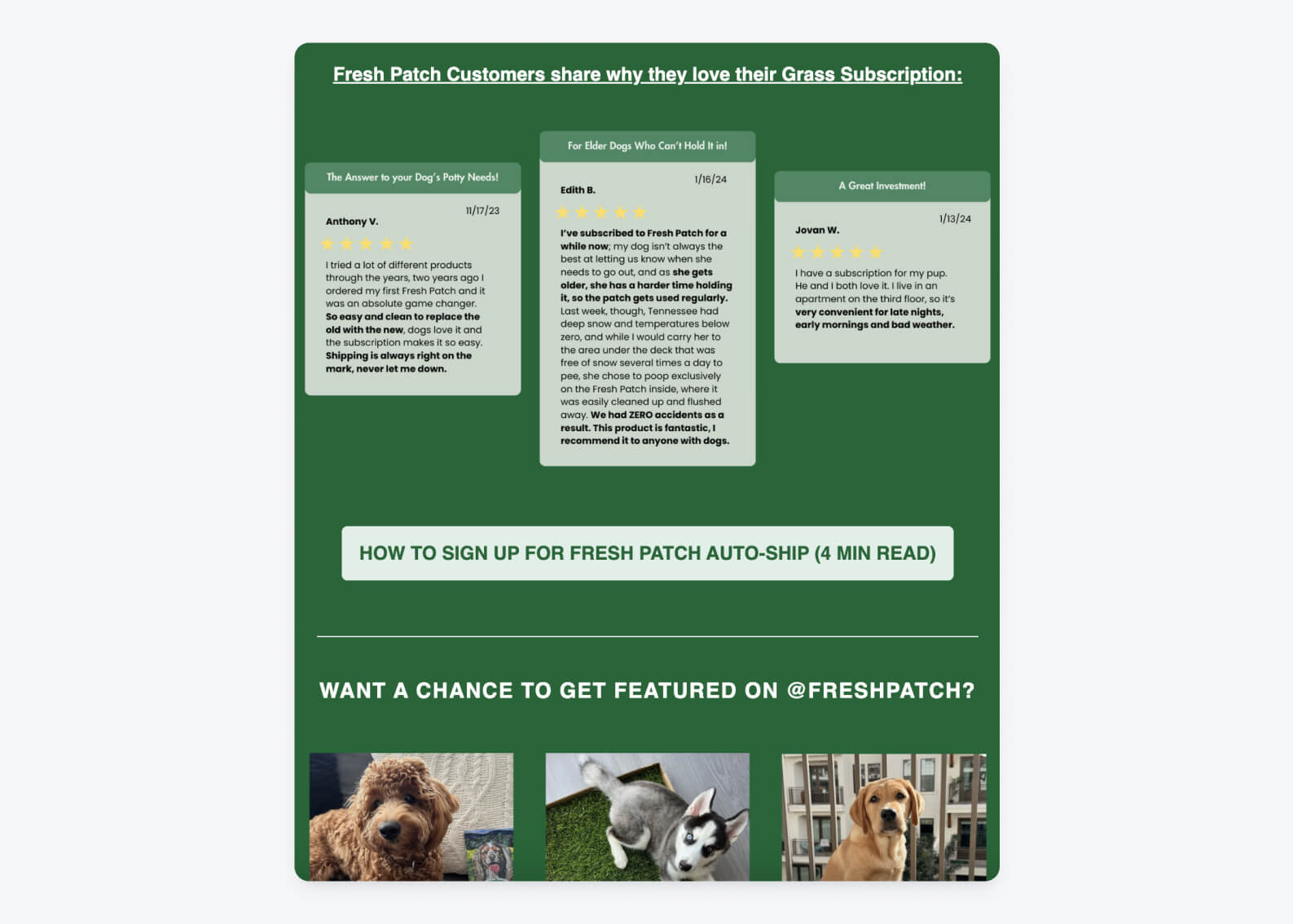
3. Call-to-Action (CTA)
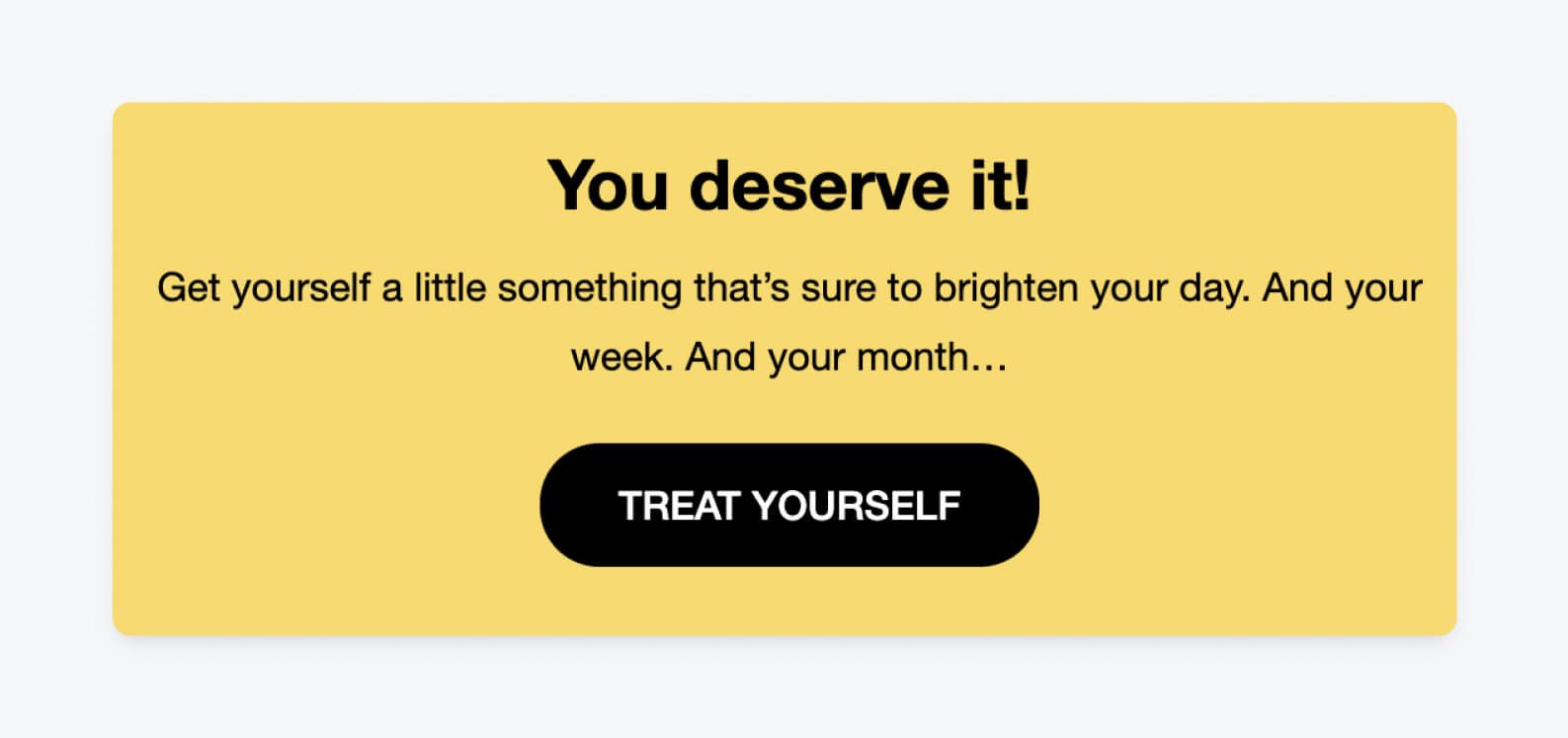
The call-to-action (CTA) is the most critical element of the email body as it prompts the recipient to take the desired action, whether it's making a purchase, signing up for a webinar, or visiting a landing page. Make the CTA clear, prominent, and action-oriented, using persuasive language to encourage immediate response. Use contrasting colors, bold fonts, or buttons to make the CTA stand out and draw attention.
Learn how to write better CTAs with our helpful guide!
Tip: Limit the number of CTAs in your email to avoid overwhelming the recipient. Focus on one primary CTA that aligns with your campaign objectives and provides a clear next step for the recipient.
Best Practices for Your Marketing Email Body:
Image Size
Optimize images for email by keeping them in a small file size (ideally under 100 KB) to ensure quick loading times and compatibility across devices. Aim for image dimensions that fit well within the email body without requiring excessive scrolling, typically around 600 pixels wide. Use JPEG or PNG formats for optimal quality and compatibility.
Email Content Length
Keep the content in your email body concise and focused, aiming for a length that can be easily scanned and understood at a glance. Avoid overwhelming recipients with lengthy paragraphs, and instead, use bullet points, short sentences, and subheadings to break up the text and improve readability.
Linking Practices
Use links strategically in your email body to drive recipients to specific landing pages, product pages, or other relevant destinations. Ensure that links are clear, descriptive, and easily clickable, using compelling anchor text that entices recipients to take action.
Typically, you want to place your most valuable link “above the scroll” or within the first three lines of your email body. As well-written as your email may be, you don’t want to bank too heavily on readers getting all the way to the bottom before bouncing. Placing your high-value link near the top of your email body keeps actionable information accessible and increases your chances of improving your click-through rates.
Avoid using too many links in a single email to prevent overwhelming recipients, and prioritize the most important links that align with your campaign objectives. Additionally, test all links before sending them to ensure they are functioning correctly.
Email Footer
An email footer is the section at the bottom of an email message that typically contains additional information about your organization, such as contact details, social media links, unsubscribe options, and legal disclaimers.
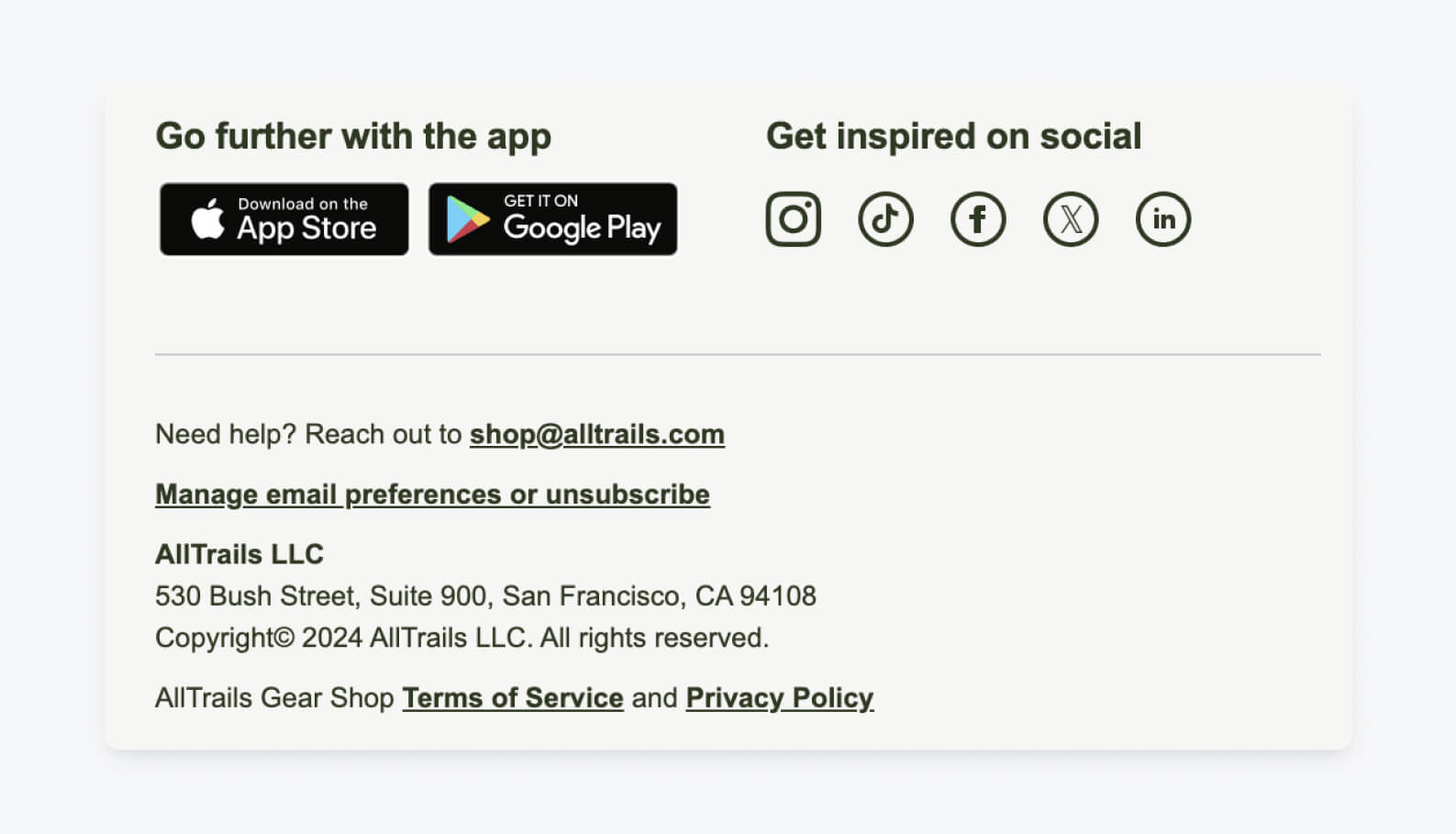
Your email footer serves as the final touchpoint of communication with the recipient and is important for several reasons. Firstly, it provides recipients with essential information, such as how to contact your business or manage their subscription preferences, improving transparency and the user experience. Additionally, an email footer reinforces brand identity and professionalism and helps ensure compliance with legal regulations and best practices for email marketing.
Consider including the following in your email footer:
- Including essential contact information such as your company's physical address, phone number, and email address.
- Providing clear unsubscribe options to allow recipients to manage their subscription preferences easily.
- Adding links to your social media profiles to encourage engagement and further interaction.
- Including legal disclaimers or privacy policy links to ensure compliance with relevant regulations.
- Keeping the footer design clean and uncluttered to maintain professionalism and readability.
OneSignal Brings Email to Mobile-First Businesses
It’s no longer enough to run traditional email marketing campaigns separate from your mobile messaging strategy. That’s why we’ve created a centralized, low-code engagement solution that allows you to compose, automate, and scale your email marketing efforts alongside your mobile marketing plans.
If you need to see it for yourself, you’re in luck. We can get you started for free!
Create a Free OneSignal Account